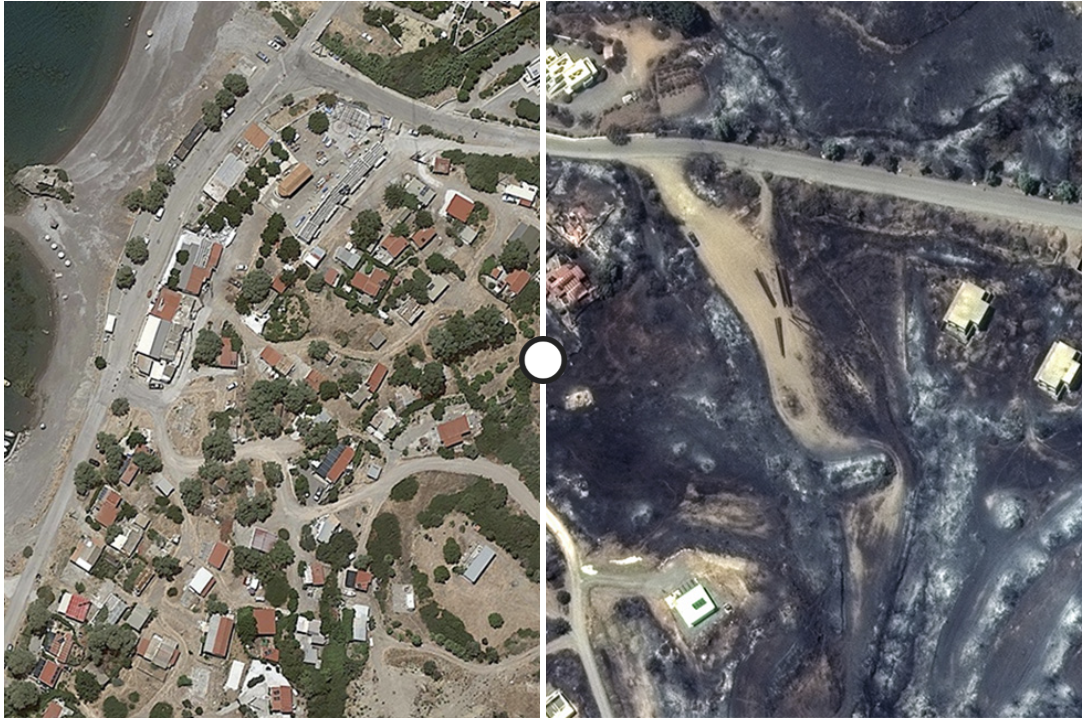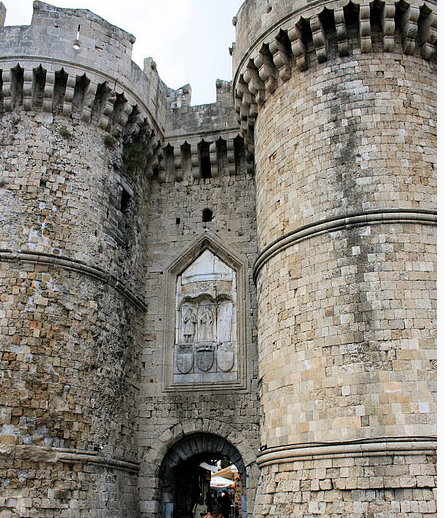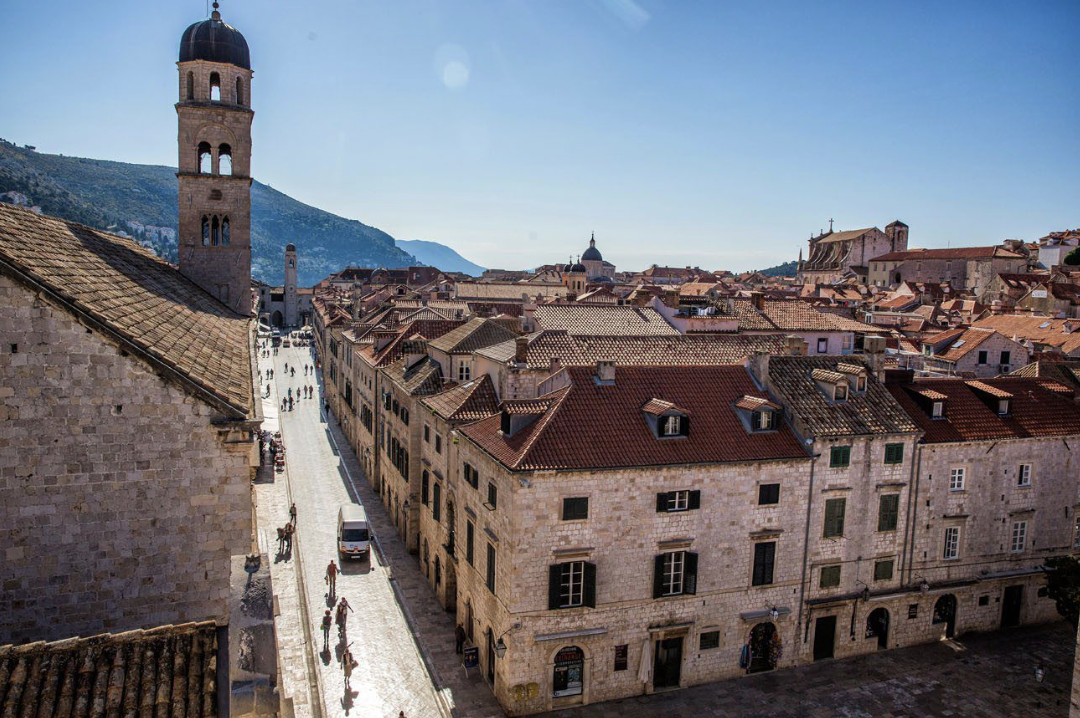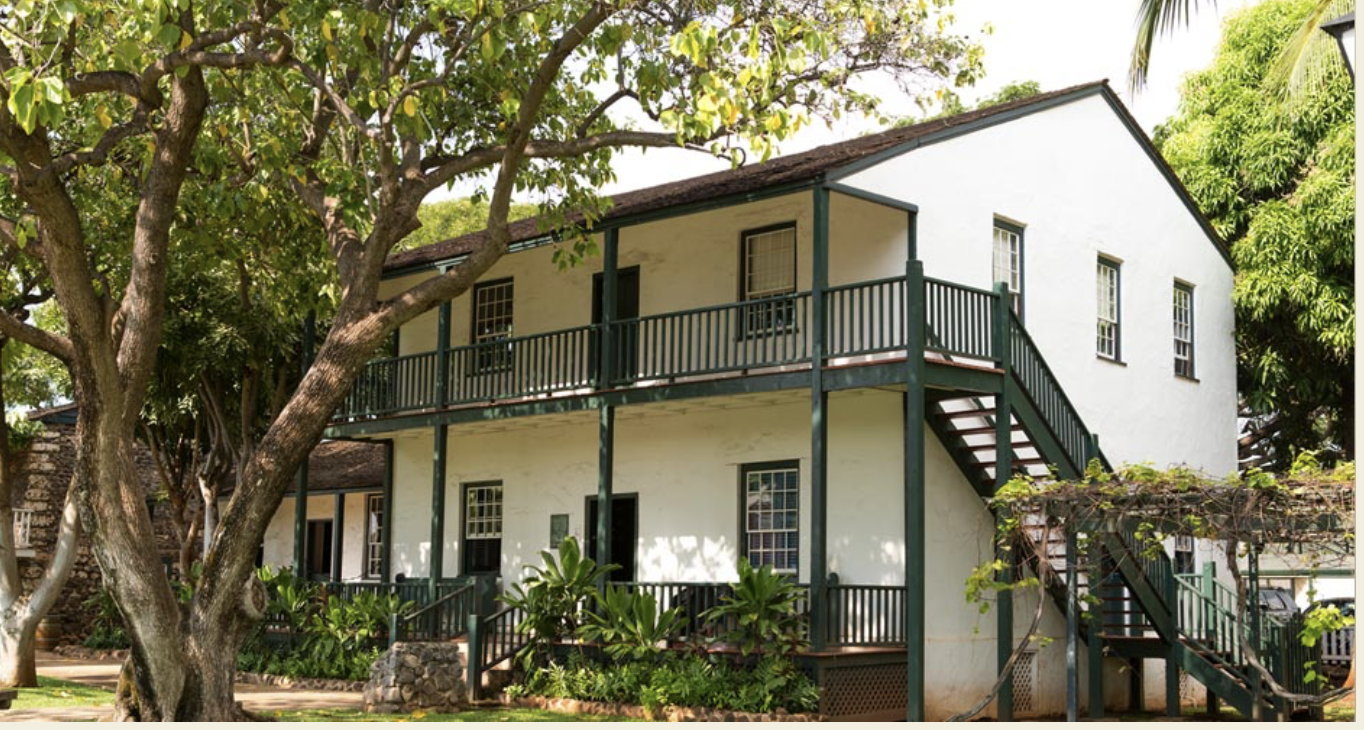Devastating Wildfires Threaten Historic Treasures
Wildfires blazed around the world this past summer with alarming intensity. The world is still feeling the effects of gigantic fires and toxic wildfire smoke. Experts continue to work to understand the impacts of these massive fires, particularly for areas that suffered multiple fires. Further complicating matters, many of these sites relied on tourist dollars for their economy. This makes the re-opening of sites (such as West Maui and specified areas on the Hawaiian west coast) fraught for local communities. Residents and government officials alike strive to balance welcoming tourists with a smile and processing their own grief and loss.
Hawaii was not the only place that suffered from wildfires. Greece, Croatia, Italy, Canada and Algeria all faced massive wildfires that obliterated homes, destroyed nature reserves, and threatened precious cultural heritage. In July, fires in Italy destroyed cultural heritage in Sicily’s Santa Maria de Gesù church. A wooden statue of the Blessed Virgin Mary and the remains of St. Benedict the Moor were both completely destroyed. That same month, additional fires on Spain’s Canary Islands forced evacuations of nearly 30,000 people, listed as two of UNESCO’s World Heritage Sites. With so much art, architecture, nature reserves, and other pieces of international heritage in danger, it’s almost as if the wildfires were specifically targeting culturally protected areas.

Wildfire burning in northern Greece. Image via Associated Press
Where did these fires coming from? Some say that unusually high temperatures and strong winds literally fanned the flames of some of the worst wildfires seen in decades. In addition to the devastating loss of lives and livelihood, vulnerable pieces of cultural heritage were severely damaged.
Now that the fires are no longer burning, cultural heritage experts around the world are able to identify scorched areas and initiate restoration efforts. Experts also pose this question: how to prevent such destruction by wildfire in the future? Especially when most of the world seems to take an ad hoc approach to cultural heritage restoration following natural disaster?
Greece
One of the hardest-hit areas was Greece. In August, Europe’s biggest wildfire in a century burned in northern Greece.
The fire covered an area larger than New York City, spanning 312 square miles. (For reference, New York City’s solid ground measures 302.6 square miles). Flames from this fire in northern Greece – primarily covering the regions of Evros, Rodopi, Alexandropoulis, Dadia, and northwestern Athens – proved devastating. The flames eradicated housing, farmland, and most of a national forest. In Evros, many took part in forced evacuations but, tragically, many lives were lost to the fires.
In early August, shocking damage occurred on the Grecian island of Rhodes. Satellite images showed Rhodes as a black scar of extensive damage. Evacuations in response to the flames forced thousands of residents to flee their homes and tourists to abandon their accommodations. The evacuations also prevented tourists from visiting cultural heritage hotspots that the island is known for. Namely, its legendary medieval village – a storied and mysterious acropolis built by crusaders within 4-km-long medieval stone walls.

Side-by-side aerial photos of Rhodes, Greece takein in 2019 (left) and 2023 (right). Image via BBC News.
From the beginning, this medieval town has been imbued with legends and dreams of glory. According to the island’s history, Rhodes was transformed into a fortified city by the Knights of St. John of Jerusalem in 1309. The Knights’ occupation was so strong, in fact, that they held the island until 1523 – surviving several takeover attempts by Turkish and Egyptian conquerors.
Military prowess aside, the Knights outdid themselves in terms of city planning. Once on the island, rather than destroying the “ancient core” of the place (which was a perfect grid – the product of 408 B.C., Hippodamian-style city planning), the Knights incorporated their plans for a fortified center as an extension of the ancient design. They further divided the town into a northern quarter, called the “Chateau,” and a southern quarter, called the “Ville.” The Chateau was where the Knights would hang out in their personal residences. They also made sure to stop by the palace of the Grand Master of the Order, which was bigger and fancier than their own abodes. Additionally (and likely for their own convenience), the Knights also made sure that all of the administrative buildings, hospital, and cathedral were located in the northern end. The Ville, in contrast, housed the laity. It’s also where the synagogues and other churches were constructed, as well as the noisy (and predictably odorous) public street market.

Medieval City of Rhodes. Image by Olbertz via Wikipedia.com.
When the Knights constructed these buildings, they went all-out in terms of style. Gothic and Renaissance designs, with a hint of Ottoman influences and a touch of Byzantine detail, manifested in a sensational conglomeration of art and architecture. Some of the buildings originally constructed as churches were later converted to mosques. Of the sacred spaces that remained churches, Agia Triada (the Holy Trinity), Agios Athanasios (St. Athanasius), Agia Alkaterini (St. Catherine), and Panagia tou Kastrou (the Virgin of the Castle), house gorgeous pieces of art and cultural heritage. The church of Agia Triada, for example, boasts stunning, original frescos. Sections of the fresco depict scenes from Ezekiel’s prophetic visions in the Bible. Other portions illustrate powerful images of Jesus’s Crucifixion on the Cross. And those frescos only scratch the surface in any tourist’s quest to discover the cultural heritage on this illustrious island.
Thankfully, the fires on Rhodes were eventually contained. Damage reports following the fires in Greece allowed cultural heritage to assess where restoration efforts would be needed. Inspections by the Climate Crisis and Civil Protection Ministry teams revealed the status of various architectural structures on-site. On Rhodes, six buildings were been designated by officials as unsafe for use. Twenty-two additional buildings were declared temporarily unfit, and seventeen others have been flagged as needing minor repairs.
The worst damage on Rhodes seems to have occurred in the local areas containing homes, hotels, businesses, and nature reserves. In fact, more than fifty homes, several popular resorts, and over 50,000 olive trees – a source of income for locals – were completely destroyed. Religious sanctuaries also suffered. The Monastery of Panagia Ipseni, in particular, became a verifiable inferno. The monastery’s olive orchards, vineyards, and religious icon workshop (all of which provided additional income for the monastery) were destroyed by the fire. The nuns – thankfully – were spared, yet had to endure watching their home erupt in flames, and their beautiful mosaic courtyard disappear under a layer of soot and ash.
However, the medieval city of Rhodes emerged relatively unscathed – possibly due to location and sheer luck. Even so, it is essential to acknowledge that, for Rhodes’ cultural heritage, escaping total destruction by wildfire was a very narrow victory. Moreover, even minor, “cosmetic” damage to ancient structures by wildfire smoke and extreme temperatures causes deterioration. The charred buildings, such as those seen in Lindos, indicate extensive damage to architecture. Extreme elements threaten to accelerate natural deterioration of delicate art within the medieval city. This alone poses increased dangers for those wishing to preserve Rhodes’ storied history. Restoration and preservation work must be given funding when rebuilding the city from the ashes in order to maintain Rhodes as a cultural heritage destination. Additionally, Grecian officials should consider enacting proactive measures geared toward cultural heritage, as well as putting in place orchestrated fire response protocols. Proactive preservation and planned response teams may save the day if this delicate art and architecture is threatened by natural disaster again.
Croatia

The Dubrovnik Walls in Croatia. Image via earthtrekkers.com.
Croatia’s stunning city of Dubrovnik marks a second European medieval town that narrowly escaped complete destruction of cultural heritage by wildfire this summer. Those lucky enough to have visited Croatia known that Dubrovnik houses vast artistic and architectural treasures. The Old City of Dubrovnik, referred to as the ‘Pearl of the Adriatic’, is listed as one of UNESCO’s World Heritage Sites. Dubrovnik emerged as a powerful city on the Dalmatian coast in the 13th century. The resulting influx of financial wealth produced a city that is a true jewel of art and artistry: Dubrovnik acts as guardian for an array of stunning churches, monasteries, palaces, and fountains. Each exquisite work of architecture demonstrates a celebration of Gothic, Renaissance, and Baroque artistic styles.
Last summer, fires in Croatia spread just south of the ancient city. Firefighters bravely fought to contain the fire, as an additional concern was that the wildfires would set off aircraft and landmines leftover from war in the 1990s. Deployment of the explosives would have posed even greater danger to the city and its beautiful cultural heritage. Fortunately, the southerly winds shifted and, with the aid of emergency personnel on the ground, Croatians were able to protect Dubrovnik’s residents and cultural heritage from damage.
Hawaii
The wildfires on Maui, Hawaii came as a shock to Americans – and were heartbreakingly deadly. 97 people were confirmed deceased, many of them children. In light of this, it is imperative to point out that the loss of cultural heritage is not the worst outcome of wildfire. Loss of human lives is the greatest tragedy; in events of wildfire and all other forms of natural disaster, loss of lives calls for our upmost recognition and respect.
The following discussion on the implications of damage done to Hawaii’s cultural heritage in the wake of the same fire should by no means overshadow the lives lost. Rather, it is intended to bring awareness to the delicacy of cultural heritage on the island, in the hopes that, by doing so, we may greater protect it in the future.
Lahaina, on the island of Maui, maintains an important place in the history of Hawaii. Listed on the National Register of Historic Places, the town rose to prominence as a whaling city in the mid-1800s. Interestingly, Lahaina was also the location of a printing press that produced the first-ever newspaper printed in the Hawaiian language. The four-page weekly paper, printed on Valentine’s Day, 1834, was called “Ka Lama Hawaii.”
Missionaries that arrived in the 1820s built Western-style architecture, including the Baldwin Home. The home was built by Rev. Ephraim Spaulding in 1834 – the same year as the Ka Lama Hawaii’s debut publication. Rev. Spaulding later returned to Massachusetts, and then lent the house to Rev. Dwight Baldwin (for whom the home is now named). Why Rev. Spaulding chose to live in the snowy echelons of Massachusetts, as opposed to the gorgeous views of Lahaina, is anyone’s guess. Regardless, the Baldwin House has since been converted into a museum, and is believed the be the oldest-surviving residence on Maui. A visit to the museum is a lesson in missionary life in an 1820s Hawaiian village – visitors can expect a tour of the house and grounds, as well as a peek into the vibrant, busy lift of the Baldwins’. The family knew how to throw a good party, and often received members of Hawaii’s royal court. For Lahainans in the 1840s, it was the place to see-and-be-seen.

The Baldwin Home on Lahaina in Maui, Hawaii. Image via Lahaina Restoration Foundation.
Unfortunately, the Baldwin Home is one of many buildings that suffered extensive damage in the fire. The House had a wooden roof, which was completely burned by flames. The Baldwin Home Museum’s director, Theo Morrison, stated (shortly after the fire) that he suspected “the entire building was gutted.” This was later confirmed.
As more reports following the fire on Maui were released, damage to other precious cultural heritage sites on the island was to be expected. Reports – most tellingly, those from Native Hawaiians – revealed that cultural landmarks, art, and architecture crucial to the Hawaiian cultural narrative were destroyed. This includes sites on Lahaina were the first Hawaiian Constitution during the kingdom era was written in the 1800s, and an ancient fish pond where Hawaiian monarchs were known to take their rest and leisure.
Although Maui is often touted as a tourist site, for Native Hawaiians, it has been long-known as the heart of their storied history. In this light, the impact of cultural heritage lost by the wildfires points to the power and enduring influence of irreplaceable art, artifacts, and historic sites. The art community must look to ways to proactively prevent vulnerable pieces of cultural heritage from destruction by extreme natural weather events. The reality is that damage done to treasured works of art and cultural heritage anywhere causes the world to lose crucial components of shared human history.
Who’s to Blame?
As the world continues to reflect on the summer wildfires, many seek to find a scapegoat for the destruction. Climate change, arson, and inefficient government response teams have all been blamed. However, at this stage in the world’s evolution, pointing fingers does little to solve the problem at hand. Loss of delicate art and cultural heritage by natural disaster is part of the new normal. If art is to be preserved for future generations, proactive protection measures should be the first line of defense.
The second line of defense should be an increased awareness of the importance of preserving such heritage, and a place for that awareness in planning for orchestrated response efforts.
The third line of defense? It’s a call to individual action, and it comes from Smokey.
 The past couple of weeks have brought several positive developments for the protection of Greek cultural heritage at the national and international levels. First, the US Ambassador to Greece, Geoffrey R. Pyatt, and the Greek Minister of Culture and Sports, Lina Mendoni,
The past couple of weeks have brought several positive developments for the protection of Greek cultural heritage at the national and international levels. First, the US Ambassador to Greece, Geoffrey R. Pyatt, and the Greek Minister of Culture and Sports, Lina Mendoni, 